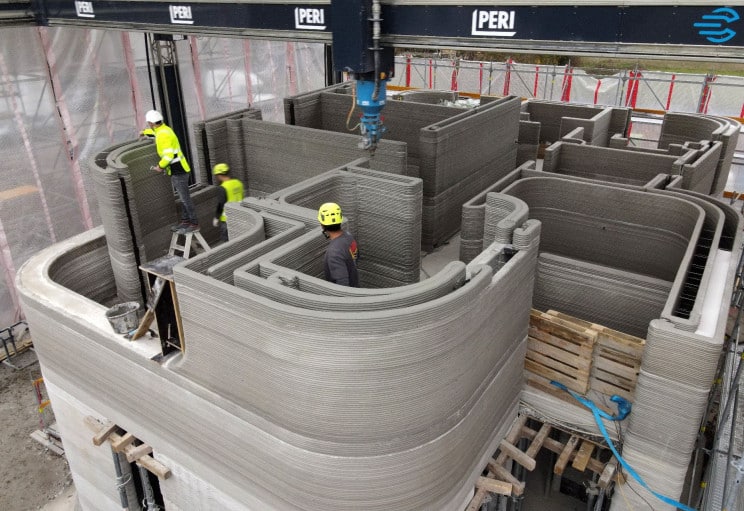3D Printed Architecture: From Models to Execution
Recent technological advancements have paved the way for a better design and architecture world. In fact, advancements have led to the creation of 3D printing, which is a relatively new concept in architecture. It is already taking the world by storm and revolutionizing the industry, as it is making the lives of architects easier by helping them create actual, detailed 3D models of their designs and then completely 3D print the actual building in a cost-effective and environmentally-friendly way. From small homes to full-scale urban structures, designers and architects are only just scratching the surface, with endless of possibilities available for the future.

Here is what you need to know about the 3D printing technology and its impact on the construction industry:
1- What it is and how it works:
Every architectural project requires a model that would help the architects, designers, as well as clients visualize the idea. This is where 3D printing comes in. 3D printing refers to various technologies that are used and that allow the creation of solid objects by laying down successive layers of raw materials, such as plastic, concrete, sand, and metal. This technology allows architects to print either 3D models, or entire buildings or structures using different techniques and methods, such as extrusion technology that allows architects to layer different kinds of materials, such as concrete, and the binding of powder method, which makes it possible to make a layer of material solid with a binder.
2- Benefits and challenges:
Just like any other technological tools, 3D printing has its advantages and disadvantages. The technology is helping clients better visualize the designs, as it makes the designs made by architects tangible. On the other hand, 3D printing is eco-friendly and time-efficient, as it reduces the time people spend on creating architectural scale models. In addition, 3D printing allows you to create high quality models that are made of different materials and then easily re-edit or re-print the models after the clients request some changes in the design. Sustainability and cost-effectiveness are also other benefits of 3D printing. However, 3D printing has its own challenges as well, in terms of the expensive initial investment in 3D printers, the ability to find printable materials, which are already quite limited, as well as buildability, structural integrity, and liability, among many others. For example, architects have faced challenges in determining whether their 3D printed building is structurally sound and whether it will be able to bear huge loads, such as furniture. On the other hand, due to lack of regulations that govern 3D printing, it is often challenging to determine who to hold responsible in case of a construction project failure. The reduced demand for labor is also another challenge, especially in poverty-stricken countries, as it impacts employment rates.
3- Impact on the construction industry:
It is obvious that the construction industry has been immensely affected by this new technology. The high-quality printers, great affordability, and new technical processes are being considered the solutions of the future, with companies, architects, and designers looking to incorporate 3D printers into their work. This new technology is already making construction faster, helping architects save time, effort, and extra materials. In fact, the technology is helping reduce a 2-week job to merely 2 or 3 days, reducing at the same time the risks of injury and the noise pollution. On the other hand, 3D printing has made a huge positive impact on the housing crisis around the world, helping build homes for the homeless in a faster and cost-effective way, especially since the printers can work non-stop for days, without needing any breaks.
4- Where we are at now and what is next:
3D printing in construction has been gaining a lot of popularity in recent years. Up until now, 3D printing has helped architects build several 3D printed buildings, including commercial buildings, residential buildings, and cabins, among many others. Today, construction giants are quickly realizing how important the 3D printing technology is becoming, with more and more companies and architects starting to use it as an alternative to traditional construction to speed up their construction process. New 3D printers are being developed to allow architects to use different kinds of materials during construction in the future. For example, printers specialized in extruding materials other than concrete are being developed, with some being able to extrude 3 layers of material all at once, including insulation foam. On the other hand, new 3D printers that will allow architects to 3D print metal structures are also now being developed, which will provide more options for architects in the future.
3D Printing Is Reshaping Construction
It is a well-known fact that the 3D printing technology is becoming more and more advanced. It is enhancing the construction industry and making the lives of architects and designers a little less stressful, especially since it reduces the amount of time spent on construction and eliminates the risk of errors when the finished product is done. And as the technology advances, architects will be able to use a wider variety of materials and designs, giving them the opportunity to 3D print more structures, whether larger buildings and bridges or small houses or even furnishings. Today, one thing is clear: 3D printing has started reshaping the construction and architecture field.
Follow Noëlla Aoun Design Studio or visit our website for more Urban Design, Architecture, Interior Design, Landscape Design, Environment, Real Estate and Sustainable Development articles.

